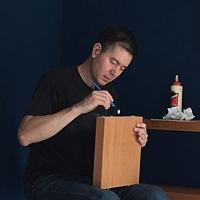Share your craft projects
Make new craft buddies
Ask craft questions
Blog your craft journey

Ron Stewart
861 posts
and
24 followers
in about 3 years
in about 3 years
More from Ron Stewart
Mini Tetrahedral Tensegrity Table Details #7: Making the Top and Bottom Disks
This is
part 7
in a
10 part
series:
Mini Tetrahedral Tensegrity Table Details
...
-
Assembling the Pyramids
-
Making the Top and Bottom Disks
-
Disk Details--Attaching the Outer Support Wires
...
...
- Assembling the Pyramids
- Making the Top and Bottom Disks
- Disk Details--Attaching the Outer Support Wires
...
I had an old scrap walnut board with lots of character that I thought would be perfect for this project. I had hoped I could resaw it in half so I could make the disks from book-matched pieces.

Unfortunately, it was twisted.

I used my planer and planer sled to flatten it. I don't use this sled very often, but it's handy when I need it.


The flattening removed enough material to dash my resawing hopes. I wanted the table's disks to be 3/8" thick, and the flattened board was too thin. I'd just have to plane the whole board down to 3/8".
The board was so short that any planer snipe would affect the disks. To avoid that problem, I first trimmed the board's wavy edges.

Then I hot-glued on some sacrificial maple strips that were about four inches longer than the walnut on each end. All of the snipe would be on the ends of those strips, keeping the entire walnut board flat.

I planed equal amounts from both faces, hoping that would minimize any post-planing warp or twist. I ended up with a nice-looking slab.

It had a few small cracks and pits around a knotty section that I would have to avoid. My design called for 6 5/8" diameter disks. I cut a hole of that size in a piece of paper and used it (and the finished pyramids) to select the best areas for the two disks.

Routing the disks was simple. The only non-trivial part was that I couldn't drill through-holes in the walnut for my Jasper circle routing jig's pivot pin. I knew I was going to need a drilling template for the disks, so I routed a disk from 3/16" thick RevolutionPly. I attached that disk to the walnut board with carpet tape.

Then I drilled partial holes into the walnut. These partial holes served two purposes. First, because the circle jig's pivot pin went through the template into the walnut, the template could not shift. Second, I could use the pivot pin to exactly align the template and the routed disks later on.
.jpg)
I used more carpet tape to attach the walnut slab to a sacrificial MDF backer and routed out the two disks.


That should have been the end of it, but I had made another mistake. I must have let the router tip while plunging it during one of my passes. One of my disks had a flat section.

I've cut dozens of circles, and this had never happened before. I couldn't sand out this error. Sanding only made it worse. The only fix was reducing the diameter of both disks (even the good one). I didn't have much leeway, because the tips of the pyramids were fairly close to the disks' edges. The best I could do was reduce the disk diameter to 6 1/2". I had to re-route the circles.
This time, I added some additional support for the circle jig.

That mostly worked. I had reduced the error, but the bad disk still had a slight flat spot. That bothered me (still does), but there was nothing more I could do. If I made the disks any smaller, they might be unusable. At least the bad disk was the bottom one.

With the disks cut, I was closer to the end of the project, but now I had to make some actual decisions about how I would attach and tension the three outer wires that would stabilize the table.








